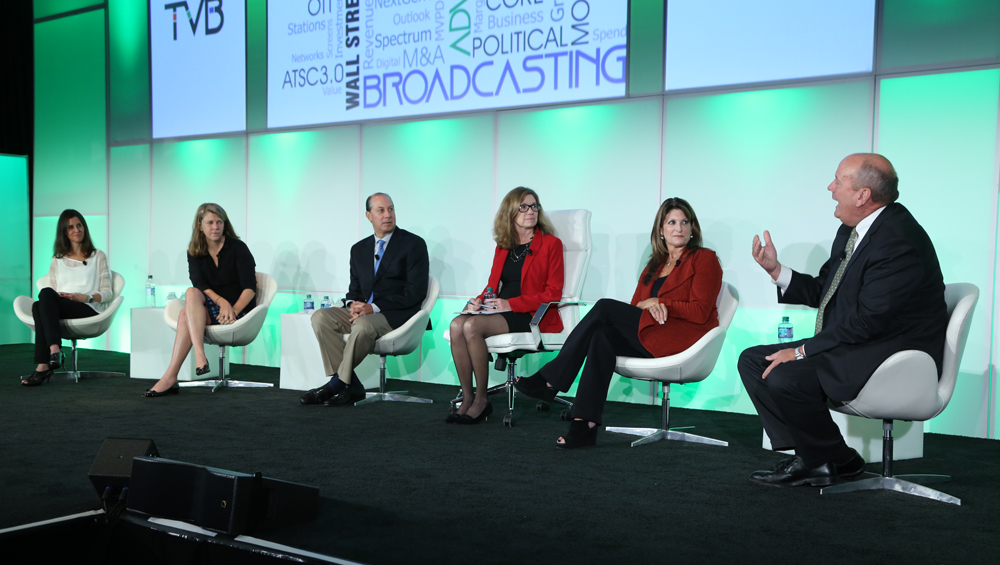
Retrans Importance Grows As Landscape Shifts

When the dust settles over the Walt Disney Co.’s deal to acquire the bulk of Rupert Murdoch’s 21st Century Fox empire, the remaining assets in the so-called New Fox could trigger trouble for Fox affiliates, according to securities analyst Michael Nathanson on a panel at the TVB Forward Conference yesterday in New York.
Nathanson referenced comments made by the session’s moderator, Robin Flynn, senior director of research at S&P Global, who noted that “CBS threw down the gauntlet … saying that they’re looking for $3 a sub in [retrans] fees, and $2 a sub from their affiliates [in reverse compensation].”
Given Fox’s heavy reliance on live sports and their high cost, Nathanson said, “I wonder if [Fox] comes out with not a $3 and $2 number, but a $4 and $3. That to me is a big potential new resetting of what the rates should be.”
There’s another possibility, he added. “At some point, does the [Fox] network say, you know what? We realize the value of local, but we will fill in the rest of the country with a national feed,” Nathanson said. “They’ll go to the nuclear option because they made a bet on national sports. I wonder what Fox will do differently, vis a vis the affiliates, as time goes on.”
With political advertising about to dwindle after the November elections, and core in an extremely low-growth mode, retransmission consent is seen as a key revenue generator for stations and dominated the panel’s talk.
Flynn noted that today, networks are getting north of 50% of stations’ retransmission consent fees in the form of so-called reverse compensation. She questioned where it would end, perhaps at 60% or higher.
“We have conservatively assumed that margins [retrans minus reverse comp] go from 50% today to somewhere in the low 40s over time,” said media analyst Marci Ryvicker, speaking of stations’ eventual retrans fee reality.
“Over time, the networks are going to have to pay for more live content, because that’s what people are watching, and they’re going to have to pay for that somehow,” commented Alexa Quadrani, manager director of equity research at JP Morgan. “They’ll continue to put pressure on the reverse comp and get larger payments from the station groups.”
Scale definitely matters, Quadrani said, noting that the smaller affiliates are paying about 75% of their retrans fees to the networks today.
The two broadcasters on the panel did not react to Nathanson’s “nuclear option” comment, which came at the end of the session, and they expressed no alarm about their ability to increase retrans and come to reasonable terms on reverse comp with the networks.
“From our perspective, the recent negotiations have been very favorable, very good. It’s not necessarily sparring over a shrinking set of assets,” said Victoria Harker, EVP-CFO of Tegna.
Another dynamic is at play, said Tom Carter, EVP-CFO of Nexstar Media Group. “There’s a greater interest on the part of the broadcast networks to buy some of their affiliates back. That only ties us together, our economics. I think we’ll end up looking a lot more alike than different.”
Carter believes that further consolidation will bring an “economic equilibrium” when negotiating with MVPDs and the networks and suggested that the retrans fees will keep going up.
The cable and satellite operators have huge bundles of channels, a large portion of which are viewed by only a small portion of subscribers. “All we’re trying to do is get the piece [of subscription revenue] that we believe we deserve based on eyeballs and viewership.”
Needless to say, there’s been erosion of subscribers to traditional MVPDs as consumers gravitate to virtual MVPDs or straight over-the-air transmissions. But Nathanson doesn’t see any immediate worries that there will be a huge falloff of the overall pay TV business.
“Until sports programming goes to Facebook, Amazon or Google, I don’t think people will give up their pay TV. Because they want to watch live sports and live news,” Nathanson said. “What we’re worried about is what happens in 2022 and 2023? Does the NFL sell their best stuff to Amazon and Facebook?” (Editor’s Note: Amazon began live streaming the NFL’s Thursday night games this week, but that didn’t come up in the conversation.)
The panel also discussed ATSC 3.0, which is still four to six years down the pike, according to Carter. He noted that the new transmission standard gives broadcasters a lot of promise when it comes to enhancing advertising revenue from a targeting and regional perspective, and it will result in the creation of new revenue streams through data delivery and services that don’t even exist today and are still in the development stages.
“It will happen in concert with the repack, which will go on until 2020,” Carter noted. “That takes care of roughly half the stations in the country, from our perspective. The stations that aren’t party to the repack will have to do it on their own.”
Media analyst Marci Ryvicker said is a “long-term benefit” that cannot be factored to her evaluations of station groups. “There are no cash flows. We have no timing; we have no idea what the cash flows are going to be. So, there’s no way to value what might come from ATSC 3.0.”
































Comments (1)
2018bstyrevr says:
September 30, 2018 at 9:10 am
Broadcasters will have a rude awakening in the next round of negotiations. They are loathed for their fake news and mundane shows , except for live sports….hope they have a good exit strategy because no one cares!!!!